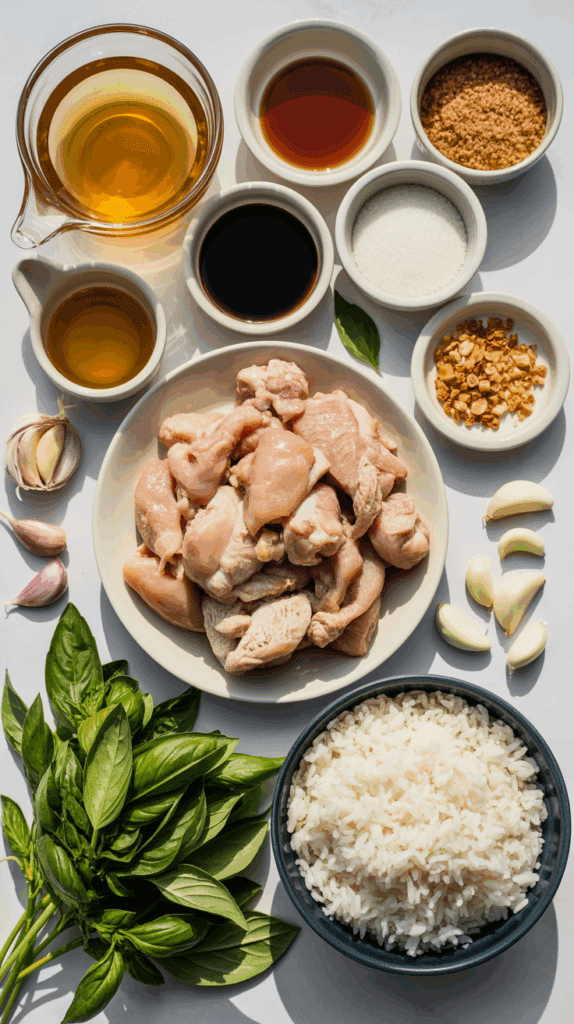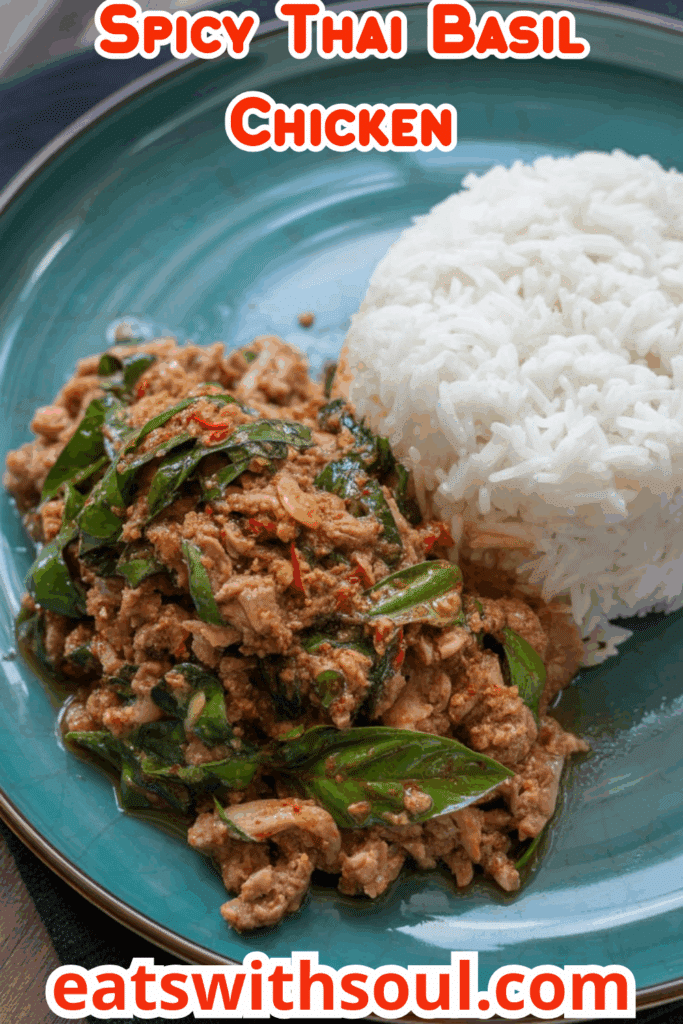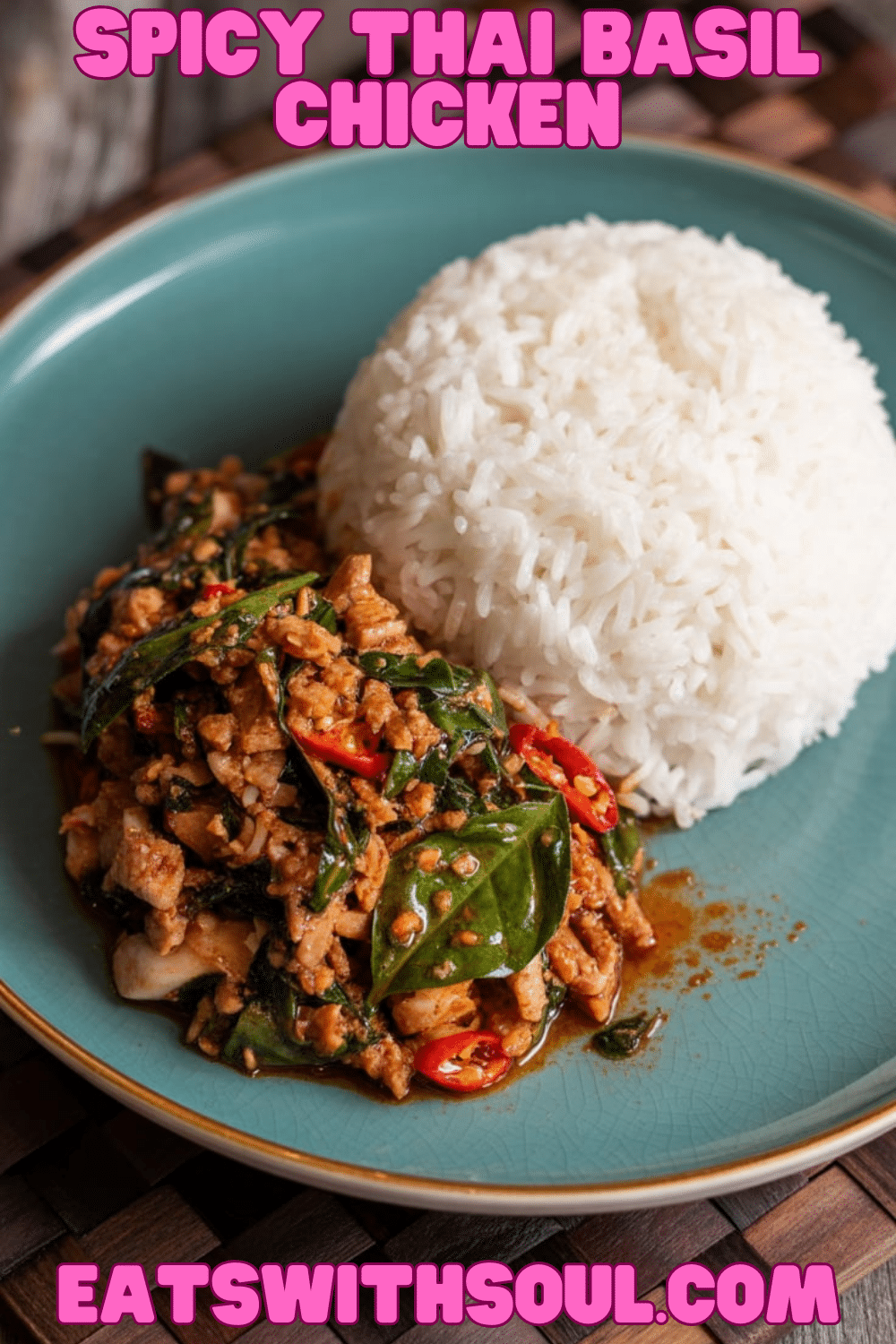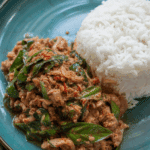Introduction & Inspiration
Prepare your taste buds for a trip to Thailand with one of its most beloved and iconic street food dishes: Spicy Thai Basil Chicken, or Pad Krapow Gai! This dish is an explosion of flavor – savory, spicy, slightly sweet, and incredibly aromatic, thanks to a generous amount of fresh holy basil (or Thai basil). We’re stir-frying coarsely chopped chicken thighs with pungent garlic, shallots, and fiery Thai chilies, then tossing it all in a perfectly balanced sauce made with oyster sauce, soy sauce, fish sauce, and a touch of sugar. It’s quick, intense, and utterly addictive!
My inspiration for this recipe comes from craving those authentic, vibrant flavors you find at the best Thai restaurants and street stalls. Pad Krapow Gai is a staple for a reason – its simplicity allows the key ingredients, especially the fragrant basil and chilies, to truly shine. Making it at home means you can customize the heat to your liking and enjoy it piping hot, fresh from the wok.
This dish is perfect for a quick weeknight dinner when you want something exciting and full of flavor. Served over steamed jasmine rice, often with a crispy fried egg on top, it’s a truly satisfying and complete meal. It is a perfect recipe for lovers of Thai food.
Nostalgic Appeal / Comfort Factor
For those who love Thai cuisine, Pad Krapow Gai is pure nostalgic comfort. It’s often one of the first dishes people fall in love with, representing the exciting, bold, and balanced flavors of Thailand – that wonderful interplay of spicy, savory, sweet, and aromatic. The sizzle of the wok and the incredible fragrance of basil and chilies hitting hot oil is an experience in itself.
Even for those new to Thai cooking, the combination of savory chicken, a flavorful sauce, and fresh herbs served over rice is universally comforting and appealing. The customizable heat level means it can be enjoyed by many.
Making this dish at home brings the vibrant energy and comforting warmth of a Thai street food stall right into your kitchen. A perfect comfort food dish with a kick.
Homemade Focus
This recipe is a fantastic example of creating an intensely flavorful, authentic Thai dish entirely from scratch using fresh ingredients and classic stir-frying techniques. You’re coarsely chopping the chicken yourself (which provides a wonderful texture), mincing fresh garlic and shallots, handling fresh chilies, and making a perfectly balanced sauce from scratch.
The homemade focus shines in the quick, high-heat stir-frying process, which requires your attention to ensure ingredients are cooked perfectly and flavors meld beautifully. The final, crucial step of wilting in a generous amount of fresh basil at the very end is a key homemade touch that defines the dish.
It celebrates the art of Thai stir-frying, showcasing how simple, fresh ingredients and proper technique can yield incredibly complex and satisfying results. The homemade sauce is incredible.
Flavor Goal
The primary flavor goal is a powerful, aromatic, and well-balanced stir-fry that is savory, spicy, slightly sweet, and bursting with the distinct peppery, anise-like flavor of holy basil (or the sweeter notes of Thai basil).
The coarsely chopped chicken thighs should be tender and juicy, with some nicely caramelized edges from the high-heat cooking. The sauce, a blend of oyster sauce, soy sauce, fish sauce, and sugars, should lightly coat the chicken and vegetables (if any were added as a variation), providing a savory, umami-rich, and slightly sweet counterpoint to the heat of the chilies. The garlic and shallots should be fragrant and foundational. The fresh basil, added at the end, is crucial for its signature aroma and flavor.
The overall experience should be an intense, fragrant, spicy, savory, and slightly sweet dish that is incredibly satisfying served over plain rice, allowing the rice to soak up the delicious sauce. A perfect balance between flavour and texture.
Ingredient Insights
- Chicken Broth, Oyster Sauce, Soy Sauce, Fish Sauce, White Sugar, Brown Sugar: These combine to create the signature savory-sweet and umami-rich sauce.
- Chicken Broth: Adds liquid volume and a savory base.
- Oyster Sauce: Thick, savory, and slightly sweet; a key umami component in many Asian stir-fries.
- Soy Sauce: Provides saltiness and umami. Use light or regular soy sauce.
- Fish Sauce: Adds a crucial pungent, salty, umami depth characteristic of Thai cuisine. A little goes a long way.
- White & Brown Sugar: Provide sweetness to balance the salty and spicy elements. Brown sugar adds a hint of molasses.
- Vegetable Oil: For high-heat stir-frying. A neutral oil like canola, grapeseed, or peanut oil works well.
- Skinless, Boneless Chicken Thighs (Coarsely Chopped): Thighs are preferred for their flavor and ability to stay moist during high-heat cooking. Coarsely chopping (not mincing) gives the dish its traditional texture, different from ground chicken.
- Sliced Shallots & Minced Garlic: Essential aromatics that form the flavor base. Shallots are milder and sweeter than regular onions.
- Minced Thai Chilies (or Serrano/other hot pepper): Provide the signature heat! Thai bird’s eye chilies are very hot. Adjust the number and type of chilies (and whether you include seeds) to control the spice level.
- Fresh Basil Leaves (Very Thinly Sliced – Chiffonade): This is THE key herb. Holy Basil (Krapow) is traditional and has a peppery, clove-like flavor. If unavailable, Thai Basil (horapha), with its anise/licorice notes, is the next best substitute. Italian basil will result in a very different, less authentic flavor. A generous amount is essential.
- Hot Cooked Rice (For Serving): Typically steamed jasmine rice, to accompany the flavorful stir-fry.
Essential Equipment
- Wok or Large, Heavy Skillet: Crucial for achieving the high heat needed for a proper stir-fry. A well-seasoned carbon steel wok or a large, heavy-bottomed skillet (cast iron or stainless steel) is ideal.
- Sharp Knife & Cutting Board: Essential for coarsely chopping chicken, slicing shallots, mincing garlic and chilies, and slicing basil.
- Small Bowl: For whisking together the sauce ingredients.
- Measuring Cups & Spoons:
- Sturdy Spatula or Stir-Fry Paddle: For efficiently moving ingredients around in the hot wok/skillet.
- Pot: For cooking rice.
Ingredients
(Original recipe yields 2 servings)
Sauce:
- ▢ ⅓ cup chicken broth
- ▢ 1 tablespoon oyster sauce
- ▢ 1 tablespoon soy sauce (or as needed)
- ▢ 2 teaspoons fish sauce
- ▢ 1 teaspoon white sugar
- ▢ 1 teaspoon brown sugar
Stir-fry:
- ▢ 2 tablespoons vegetable oil
- ▢ 1 pound skinless, boneless chicken thighs, coarsely chopped into small, irregular pieces
- ▢ ¼ cup sliced shallots
- ▢ 4 cloves garlic, minced
- ▢ 2 tablespoons minced Thai chilies, Serrano, or other hot pepper (adjust to taste; remove seeds for less heat)
- ▢ 1 cup very thinly sliced fresh basil leaves (preferably Holy Basil or Thai Basil), packed
- ▢ (Implied but missing from list: Salt & Pepper to taste for chicken if desired initially, though sauces are salty)
For Serving:
- ▢ 2 cups hot cooked rice (e.g., jasmine rice)

Step-by-Step Instructions
1. Prepare Ingredients (Mise en Place):
- Gather all your ingredients. Coarsely chop the chicken thighs into small, bite-sized, somewhat irregular pieces. Thinly slice the shallots. Mince the garlic and the Thai chilies (wear gloves if sensitive!). Very thinly slice (chiffonade) the fresh basil leaves.
- Cook your rice according to package directions so it’s ready when the stir-fry is done.
2. Mix the Sauce:
- In a small bowl, whisk together the ⅓ cup chicken broth, 1 tablespoon oyster sauce, 1 tablespoon soy sauce, 2 teaspoons fish sauce, 1 teaspoon white sugar, and 1 teaspoon brown sugar until the sugars are mostly dissolved and everything is well blended. Set aside.
3. Stir-fry Chicken:
- Heat a large wok or heavy skillet over high heat until very hot (oil should shimmer or a drop of water evaporates instantly).
- Drizzle in the 2 tablespoons of vegetable oil, swirling to coat the bottom.
- Add the coarsely chopped chicken to the hot wok. Stir-fry quickly, spreading the chicken out, until it loses its raw pink color and starts to lightly brown in spots, about 2 to 3 minutes.
4. Add Aromatics and Chilies:
- Push the chicken to one side of the wok. Add the sliced shallots, minced garlic, and minced Thai chilies to the cleared space.
- Continue cooking on high heat, stir-frying the aromatics and chilies for about 1 minute until fragrant. Then, stir everything together with the chicken.
- Continue to cook and stir until some of the chicken juices start to caramelize on the bottom of the wok, about 2 or 3 more minutes.
5. Deglaze and Add Sauce:
- Add about a tablespoon of the prepared sauce mixture to the wok. Cook and stir quickly, scraping the bottom of the wok to loosen any caramelized bits (deglazing), until this small amount of sauce begins to caramelize, about 1 minute.
- Pour in the rest of the prepared sauce mixture. Cook and stir until the sauce has fully deglazed the bottom of the wok and comes to a vigorous simmer.
- Continue to cook and stir until the sauce glazes onto the meat and thickens slightly, about 1 or 2 more minutes.
6. Stir in Basil:
- Remove the wok from the heat.
- Immediately add the 1 cup of thinly sliced fresh basil leaves to the hot chicken and sauce.
- Cook and stir for about 20 seconds, just until the basil is wilted and has released its fragrance. Do not overcook the basil.
7. Serve:
- Serve the Spicy Thai Basil Chicken immediately over hot cooked jasmine rice.
- Enjoy the incredibly aromatic and flavorful dish! A traditional accompaniment is often a crispy fried egg (khai dao) on top.

Troubleshooting
- Chicken Tough/Dry: Overcooked, or pieces cut too small and cooked too long. Chicken thighs are forgiving, but high-heat stir-frying is quick. Cook just until done.
- Sauce Too Salty: Soy sauce and fish sauce brands vary in saltiness. Use low-sodium soy if preferred. Taste sauce before adding all to chicken.
- Sauce Too Sweet: Adjust sugar amounts to your preference.
- Basil Turns Black/Loses Flavor: Added too early or cooked too long. Basil is delicate; stir it in off heat or for just a few seconds at the very end.
- Chilies Too Overwhelmingly Spicy (or Not Spicy Enough): The number and type of chilies (and whether seeds are included) dictate the heat. Adjust to your tolerance. Have all ingredients prepped to avoid aromatics burning while you chop.
- Not Enough Sauce/Too Dry: Sauce reduced too much. Cook quickly once sauce is added. Have a little extra broth ready to splash in if it gets too dry too fast.
Tips and Variations
- Holy Basil (Krapow) is Ideal: If you can find it at an Asian market, holy basil provides the most authentic peppery, slightly clove-like flavor. Thai basil (horapha) is the next best substitute with its anise notes. Italian basil will give a very different result.
- Coarsely Chopped Chicken: This texture is traditional and preferred over finely minced or ground chicken for this dish, as it provides better bite.
- High Heat, Quick Cooking: The essence of stir-frying! Have all your ingredients prepped and ready by the wok (“mise en place”) before you start, as the cooking process is very fast.
- Wok Hei: For that elusive “breath of the wok” smoky flavor, ensure your wok is extremely hot and don’t overcrowd it (cook in batches if necessary).
- Ground Meat Option: While chopped is traditional, ground chicken, pork, or beef can also be used for a quicker prep version (Pad Krapow Moo/Nua).
- Add Vegetables: Sliced green beans, bell peppers, or onions are common additions. Add them with the shallots/garlic and stir-fry until tender-crisp before adding the sauce.
- Fried Egg Topping (Khai Dao): A crispy-edged, runny-yolk fried egg served on top is a very popular and delicious traditional accompaniment to Pad Krapow Gai. Highly recommended!
Serving and Pairing Suggestions
- Serve Immediately: Best enjoyed hot and fresh from the wok.
- With Steamed Jasmine Rice: The essential accompaniment to soak up the flavorful sauce.
- Topped with a Fried Egg: As mentioned, a crispy fried egg (khai dao) is a classic and delicious addition.
- Side of Cucumber Slices: Cool cucumber provides a refreshing contrast to the spice.
- Beverage: Thai iced tea or a cold lager beer are great pairings.
Nutritional Information
(Note: Estimated, per serving, assuming 2 servings. Variable based on chicken thigh fat, exact sauce quantities, oil used.)
- Calories: 450-600+
- Fat: 25-35g+
- Saturated Fat: 5-9g+
- Cholesterol: 150-200mg+
- Sodium: 1200-1800mg+ (Soy sauce, oyster sauce, fish sauce are high in sodium)
- Total Carbohydrates: 15-25g+ (Mostly from sugars in sauce)
- Dietary Fiber: 1-3g+
- Sugars: 10-15g+
- Protein: 35-45g+
Authentic Spicy Thai Basil Chicken (Pad Krapow Gai)
Make authentic Spicy Thai Basil Chicken (Pad Krapow Gai)! This quick and easy stir-fry features chopped chicken, fiery Thai chilies, garlic, shallots,
Ingredients
(Original recipe yields 2 servings)
Sauce:
- ▢ ⅓ cup chicken broth
- ▢ 1 tablespoon oyster sauce
- ▢ 1 tablespoon soy sauce (or as needed)
- ▢ 2 teaspoons fish sauce
- ▢ 1 teaspoon white sugar
- ▢ 1 teaspoon brown sugar
Stir-fry:
- ▢ 2 tablespoons vegetable oil
- ▢ 1 pound skinless, boneless chicken thighs, coarsely chopped into small, irregular pieces
- ▢ ¼ cup sliced shallots
- ▢ 4 cloves garlic, minced
- ▢ 2 tablespoons minced Thai chilies, Serrano, or other hot pepper (adjust to taste; remove seeds for less heat)
- ▢ 1 cup very thinly sliced fresh basil leaves (preferably Holy Basil or Thai Basil), packed
- ▢ (Implied but missing from list: Salt & Pepper to taste for chicken if desired initially, though sauces are salty)
For Serving:
- ▢ 2 cups hot cooked rice (e.g., jasmine rice)
Instructions
1. Prepare Ingredients (Mise en Place):
- Gather all your ingredients. Coarsely chop the chicken thighs into small, bite-sized, somewhat irregular pieces. Thinly slice the shallots. Mince the garlic and the Thai chilies (wear gloves if sensitive!). Very thinly slice (chiffonade) the fresh basil leaves.
- Cook your rice according to package directions so it’s ready when the stir-fry is done.
2. Mix the Sauce:
- In a small bowl, whisk together the ⅓ cup chicken broth, 1 tablespoon oyster sauce, 1 tablespoon soy sauce, 2 teaspoons fish sauce, 1 teaspoon white sugar, and 1 teaspoon brown sugar until the sugars are mostly dissolved and everything is well blended. Set aside.
3. Stir-fry Chicken:
- Heat a large wok or heavy skillet over high heat until very hot (oil should shimmer or a drop of water evaporates instantly).
- Drizzle in the 2 tablespoons of vegetable oil, swirling to coat the bottom.
- Add the coarsely chopped chicken to the hot wok. Stir-fry quickly, spreading the chicken out, until it loses its raw pink color and starts to lightly brown in spots, about 2 to 3 minutes.
4. Add Aromatics and Chilies:
- Push the chicken to one side of the wok. Add the sliced shallots, minced garlic, and minced Thai chilies to the cleared space.
- Continue cooking on high heat, stir-frying the aromatics and chilies for about 1 minute until fragrant. Then, stir everything together with the chicken.
- Continue to cook and stir until some of the chicken juices start to caramelize on the bottom of the wok, about 2 or 3 more minutes.
5. Deglaze and Add Sauce:
- Add about a tablespoon of the prepared sauce mixture to the wok. Cook and stir quickly, scraping the bottom of the wok to loosen any caramelized bits (deglazing), until this small amount of sauce begins to caramelize, about 1 minute.
- Pour in the rest of the prepared sauce mixture. Cook and stir until the sauce has fully deglazed the bottom of the wok and comes to a vigorous simmer.
- Continue to cook and stir until the sauce glazes onto the meat and thickens slightly, about 1 or 2 more minutes.
6. Stir in Basil:
- Remove the wok from the heat.
- Immediately add the 1 cup of thinly sliced fresh basil leaves to the hot chicken and sauce.
- Cook and stir for about 20 seconds, just until the basil is wilted and has released its fragrance. Do not overcook the basil.
7. Serve:
- Serve the Spicy Thai Basil Chicken immediately over hot cooked jasmine rice.
- Enjoy the incredibly aromatic and flavorful dish! A traditional accompaniment is often a crispy fried egg (khai dao) on top.
Recipe Summary and Q&A
Summary: This Spicy Thai Basil Chicken (Pad Krapow Gai) involves whisking together a sauce of chicken broth, oyster sauce, soy sauce, fish sauce, and sugars. Coarsely chopped chicken thighs are stir-fried in hot oil until they lose their raw color. Sliced shallots, minced garlic, and minced Thai chilies are added and stir-fried until fragrant and juices caramelize. A small amount of sauce is added to deglaze, followed by the remaining sauce, which is cooked until it glazes the meat. A generous amount of thinly sliced fresh basil is stirred in at the very end until just wilted. The dish is served hot over rice.
Q&A:
A: Stir-fries like this are truly best made fresh and served immediately to preserve the texture of the chicken and the vibrancy of the fresh basil. Reheating can overcook the chicken and dull the basil flavor. You can prep all the components (chop veggies/chicken, mix sauce) ahead of time, then the stir-fry itself takes only minutes.
Q: What’s the difference between Holy Basil and Thai Basil? Can I use Italian Basil?
A: Holy Basil (Krapow) has a distinct peppery, spicy, almost clove-like flavor and is traditional for this dish. Thai Basil (Horapha) has a more anise or licorice-like flavor and is a good substitute. Italian basil has a very different sweet, grassy flavor and is not recommended if you want an authentic Pad Krapow taste.
Q: This recipe seems very spicy with 2 tablespoons of minced Thai chilies! How can I adjust the heat?
A: You are right, Thai chilies are very hot! The amount of chilies is highly personal. For less heat: 1) Use fewer chilies (start with 1-2). 2) Carefully remove all the seeds and white membranes from the chilies before mincing, as that’s where much of the capsaicin (heat) is concentrated. 3) Use a milder chili like Serrano, but the flavor will be different.
Q: Why coarsely chop the chicken instead of using ground chicken or slices?
A: Coarsely chopping the chicken (or sometimes hand-mincing) is the traditional preparation for Pad Krapow Gai. It provides a pleasant, slightly rustic texture that’s different from ground meat (which can be too fine) or larger slices. It allows the chicken to grab onto the sauce well and provides a satisfying bite.
Q: Can I make this ahead of time?

